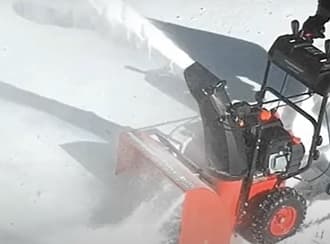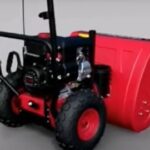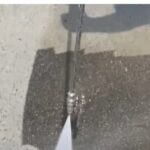As an Amazon Associate, this site earns commissions from qualifying purchases. For more information click here.
If your area experiences a lot of heavy snow, it makes sense to get a snow blower. In case snow covers your driveway, a blower will clear much faster and more efficiently than a shovel. But how well do these machines handle packed snow?
The most common snow blowers are one, two and three stage models. A two or three stage snow blower is the best option to clear packed snow because it is powerful and efficient.
What Snow Blower Type is Best For Packed Snow?
The type of snow you need to clear determines what kind of snow blower you should use. If you are dealing with packed snow and ice, you need a two or three stage snow blower. In the following section we explain what that is and how it affects your ability to clear snow.
Quick note: if you are in a hurry and need a snow blower right now, we recommend the 250cc PowerSmart Snow Blower. It is built for packed snow and can clear ice without trouble. If you want to know more about the different types of snow blowers, keep reading.
Snow blower types are classified as stages. There are three: single (one), dual (two) and triple (three).
Single Stage Snow Blowers
Single stage snow blowers are not capable of clearing packed snow. These are lightweight tools and capable of handling only 6-12 inches of light snow.
These blowers can throw snow more than 30 feet but cannot break up large ice or heavy snow. A single stage snow blower is only suitable for level ground and the surface must be free of rocks and debris.
Packed snow and ice requires more power than a single stage snow blower can handle. It will take longer to finish the job and the blower might start running rough.
Dual Stage Snow Blowers
A dual or two-stage snow blower can clear up to 23 inches of snow and ice. Whether the snow is icy, wet or packed, a two-stage snow blower is good for driveways up to 60 feet long, and they sport an ergonomic design to reduce fatigue.
What makes two-stage snow blowers suited for packed snow is their mechanism. The process begins when the auger gathers the snow, which an impeller fan then discards via a chute.
A two-stage snow blower is more powerful and versatile than a single stage unit. It can hurl snow up to 60 feet and is faster too. You can also put skid shoes on a dual stage snow blower for use on grounds without paving.
Three Stage Snow Blowers
A three-stage snow blower is even more powerful than a two-stage model. It works similarly to a two-stage snow blower except it has an accelerator.
The accelerator works with the impeller fan and the auger to clear snow. The accelerator in particular is useful in breaking up large ice chunks.
If you have a large driveway, a three-stage snow blower is a good option. But for most homes a two-stage snow blower is going to be enough. It depends on the kind of snow you face and how much of it.
Gas vs. Electric Snow Blower: Which is Better for Heavy Snow?
A gas snow blower is more suited for heavy snow than an electric or cordless model. It can clear more snow, break more ice and last longer. Electric and cordless snow blowers are useful for moving light snow.
Electric and cordless snow blowers are suitable for clearing snow on a patio, deck or any small area. They are low cost, easy to use and dependable.
But for a driveway or other large areas covered by lots of snow, a 2 or 3-stage gas snow blower is the best option. With a gas-powered blower such as the PowerSmart 212cc you don’t have to worry about any electrical cords or a battery running low.

How to Break Packed Snow with a Snow Blower
The first step is to wear the right clothing. Assuming you have a 2 or 3 stage snow blower already, follow all the safety instructions in your owner’s manual.
To break packed snow, turn the snow blower on and guide it in the direction you want. The auger and impeller fan (and accelerator if it is a three-stage) will do the work. You just need to orient the blower where it has to go.
If the snow is too packed or the ice is too large, break them into smaller chunks. This should allow the augers to go through the snow without difficulty.
All of these assumes your snow blower has enough power for the task. As pointed out earlier, a 2 or 3 stage snow blower is needed for clearing heavy snow.
Do Snow Blowers Work on Wet and Heavy Snow?
Wet and heavy snow is difficult to clear so a powerful snow blower is needed. Wet snow takes a lot of effort to work with, and it is also the most dangerous for the operator. To remove this type of snow, you need a powerful blower and safety gear.
If the snow is too heavy, the engine might get clogged. Turn the engine off and remove the blockage. In some cases it helps if you apply silicone spray on the snow blower. According to some operators this helps the machine handle wet, heavy snow better.
Slush is one of the problems you might face when using a snow blower. Can the machine go through this? Yes, but you have to be more careful when maneuvering the snow blower.
Keep in mind that its mechanism can only throw so much snow. If it is constantly ejecting heavy snow and ice, that will take its toll on the engine.
Bottom line: you must have a quality and powerful snow blower to clear wet snow and slush. It can be done but you have to be careful and thorough about it.
Tips on How to Use a Snow Blower Efficiently
Rule number one is not to wait for the snow to stop before you start clearing. If the snow is less than six inches, it means less stress on the snow blower and less work for you. If you wait for the snow to pack, it is going to take a lot more effort.
Make sure the snow blower throws the snow as far as it is capable of. If not, the snow might end up back a few feet where it was before and the blower has to throw it away again. This is going to take its toll on the engine. Over time this could lead to faster wear and tear.
Clear the area as much as you can. This means removing items like the garden hose, rocks, plants and other stuff that could get in the way.
Take your time. The worst thing you can do is to set the snow blower at max speed and go right through the snow.
If the snow is packed tight with a lot of ice, the blower could stall. Worse, the drive belt or other components could break if it suddenly strikes something hard like solid ice.
A better approach is to make a smaller pass, around half of the snow blower size. This might seem counter intuitive, but doing this actually speeds up the process. There is less pressure on the snow blower and it can hurl the snow farther.
Use fresh fuel. Anytime the machine has to deal with heavy snow, it must have the right amount of fuel. Follow the owner’s manual instructions for adding and if they recommend a specific type. Most snow blowers are 4-stroke so no need to mix oil and gas.
If your snow blower runs out of fuel while clearing ice, let it cool before refilling. A hot engine and a gas tank needs to be handled carefully. Give the engine about 10-15 minutes to cool down before you refill it with fuel.

I love the outdoors and all the tools for maintaining gardens, yards and lawns. The only thing I am more passionate about is sharing what I know about garden and outdoor equipment.


